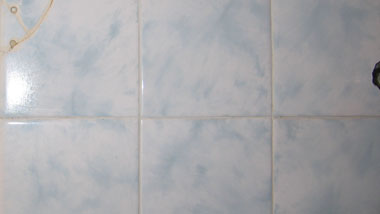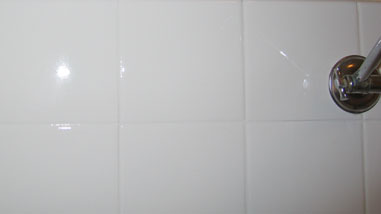Tile Resurfacing
Tile resurfacing (aka tile refinishing, tile re-glazing) transforms the appearance of old bathroom wall tiles without any of the mess and disruption associated with ripping them out and retiling. In addition to minimal downtime and inconvenience, tile resurfacing is also cheaper and has the advantage of preventing grout mould.
What is Tile Resurfacing?Tile resurfacing is a technique for repairing and resurfacing tiles using proprietary resurfacing materials designed for bathroom wet areas. The appearance and durability of tile resurfacing depends largely on thorough preparation and skilled application. The cheapest quote might save a few dollars upfront, but may never look as good or last as long.
The procedure followed by bathroom resurfacing applicators who have been trained in the correct application of Worldwide Refinishing Systems can be summarized as follows:
The tile resurfacing process is similar to the bath resurfacing process. |  Cleaning, repairs and application of primer system. |
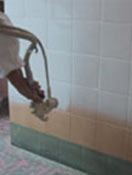 Professional spray application gives uniform dry film thickness. |
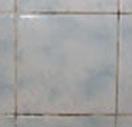 Grout mould embedded in deteriorating grout lines is both unsightly and unsanitary. |
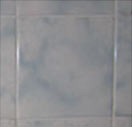 Grout lines after cleaning out and re-grouting to give smooth profile before resurfacing. |
|
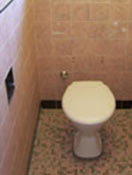 Before: Old, dated wall & floor tile colours and designs. |
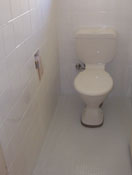 After: Gleaming white walls and floor - a different place to be! |
|
Home much does Tile Resurfacing cost?There is no set average cost per m2 for tile resurfacing. It depends on the extent of repairs, general condition of the tiles, size of area to be resurfaced and whether other resurfacing is to be completed at the same time.
However, the cost of tile resurfacing when compared with the entire process of ripping out, water-proofing and retiling represents a very considerable saving. Read more about resurfacing costs.
Your local Worldwide Refinishing Systems accredited bathroom resurfacing applicator will be pleased to inspect and quote for your specific requirements without obligation on your part.
Call 1300 360 660 today. You won't be disappointed! |
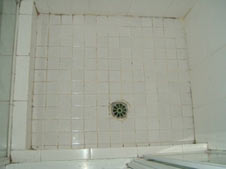 Before: Tiled shower base with mould and damaged grout lines. |
|
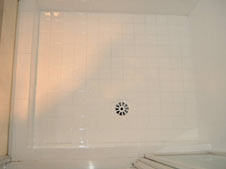 After: Resurfaced tile shower base with sealed grout lines. |
||
Floor Tile ResurfacingEpoxy and Urethane floor coatings are not as hard as the glass hard, kiln fired finish on floor tiles, so loss of gloss will occur more quickly in doorways and other areas of heavy foot traffic. Whether a simple coloured epoxy finish or a multi-speckled stone effect, professional application will require 2 or more additional visits after bath and wall tile resurfacing have been completed. Since bathroom floor areas are usually small, the cost when expressed on a $ per m2 basis is therefore higher than for wall tile resurfacing.
PLEASE NOTE - Floor tile resurfacing is not available in all serviced areas. You may check availability by calling 1300 360 660. |
||
Diagnosing Tile System ProblemsApart from old colours, old designs and grout mould, there can be other problems with bathroom tiles: |
||
| Grout Lines Shrinkage, cracked tiles and missing grout in the shower area will allow water penetration, leading to dampness in the wall behind and the formation of mould. Applicators may if necessary re-grout an entire bathroom prior to resurfacing to ensure a uniform appearance prior to resurfacing. |
Crazing Caused by volume increase in a tile after moisture absorption through porosity, usually over a period of years. Mild crazing may be less noticeable after resurfacing but severe crazing may still be partially visible under the new surface. |
|
| Cracks Cracked tiles may have been caused by settlement cracks in the wall structure, vibration or impact damage. Cracks can be filled, but may not be completely invisible if there is any noticeable deflection in the face of the affected tiles. |
Holes & Chips Usually the result of replacing old fittings. Can be repaired by shaping and applying waterproof filler. Correctly repaired holes and chips are invisible after resurfacing. |
|



